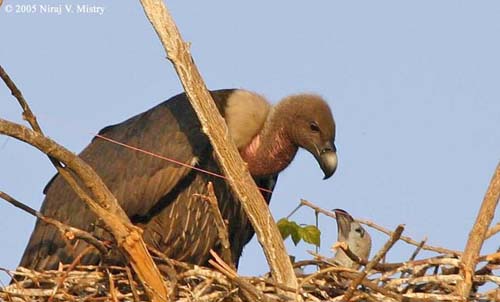
White-rumped Vulture
Gyps bengalensis
Accipitriforme Order – Accipitridae Family
BIOMETRICS:
Length: 76-93 cm
Wingspan: 205-220 cm
Weight: 3500-6000 g
DESCRIPTION:
This species is an Old World vulture, different from the African White-backed Vulture – Gyps africanus, from Africa.
Also known as Indian White-backed Vulture, Oriental White-backed Vulture and White-rumped Vulture, this raptor is now Critically Endangered after this species was considered as “probably the most abundant large bird of prey in the world”. The White-rumped Vulture suffered important declines in the 1990s, and it is now rare within its range.
Fr: Vautour chaugoun
All : Bengalengeier
Esp: Buitre Dorsiblanco Bengalí
Ital: Grifone dorsobianco del Bengala
Nd: Bengaalse Gier
Russe: Бенгальский сип
Sd: Bengalgam
Photographer :
Niraj V. Mistry
Photo Galleries
Text by Nicole Bouglouan
Sources :
HANDBOOK OF THE BIRDS OF THE WORLD Vol 2 by Josep del Hoyo-Andrew Elliot-Jordi Sargatal - Lynx Edicions - ISBN: 8487334156
Wikipedia (Wikipedia, The Free Encyclopedia)
Other article: The Old World Vultures

White-rumped Vulture adult is a medium-sized vulture. It has blackish upperparts with silvery-grey flight feathers. Lower back and rump are pure white, giving the bird its name.
The underparts are brownish-black, finely streaked creamy-white. On the underwings, coverts are all white, well visible in flight. Undertail coverts are black.
Head and neck are dark brown with pinkish-white downy crown and nape. We can see a white ruff at neck base.
The hooked bill is brownish-black with darker cere. Eyes are brown. Legs and feet are black.
Both sexes are similar.

Juvenile is dark brown with streaked underparts. Head and neck are brown with paler ruff. Bill is grey. It reaches the adult plumage at 4-5 years of age.
VOICE: SOUNDS BY XENO-CANTO
As all vultures, the White-rumped Vulture utters sounds mainly at carcasses, when disputes and interactions occur between several raptors’ species. We can hear series of grunts, croaks, hisses, screeches and high-pitched chatters.
HABITAT:
White-rumped Vulture frequents open country near villages and towns. It can be seen in parks and it is often closely associated with human.
It also may be found in lowlands, and foothills up to 1500 metres of elevation. Vultures often gather at slaughterhouses and rubbish-dumps near towns and cities.
RANGE:
White-rumped Vulture is found in SE Iran, Afghanistan and Pakistan, through Nepal and India to SC China, Indochina and N Malay Peninsula.

BEHAVIOUR:
White-rumped Vulture feeds exclusively on carrion, mainly remains of cattle. Unfortunately, this food caused large declines in vultures’ populations since the 1990s. The veterinary use of Diclofenac leaves traces in the cattle carcasses, involving poisoning for vultures and other scavengers.
White-rumped Vulture often feeds with other vultures’ species such as Long-billed Vulture – Gyps indicus, and other scavengers, birds and mammals.

White-rumped Vulture spends the most of the time perched on trees or roofs, often near human habitations.
These vultures often gather in large numbers at roosts in trees, where they remain perched for long time. They usually perch on the same trees which die little by little, due to the accumulation of droppings. This fact is sometimes a big problem in groves of coconut palms and other exotic plantations.

When the breeding season begins, we can see the pairs flying together, performing mutual soaring as flight displays.
White-rumped Vulture is sedentary within its range.
FLIGHT:
White-rumped Vulture is often seen soaring during long periods in thermal currents, circling slowly with almost motionless wings.

REPRODUCTION:
Breeding season occurs from October to March-April.
These vultures sometimes nest in small colonies in trees. The nest is made with sticks and lined with green leaves by both adults. It is situated in large tree, between 5 and 30 metres above the ground, often near village or town, close to a road or a stream.


Female lays one white egg tinged bluish-green. Incubation lasts about 45 to 48 days, shared by both parents. Fledging period may last up to three months.

DIET:
White-rumped Vulture is a scavenger, feeding exclusively on carrion, and mainly carcasses of cattle.
PROTECTION / THREATS / STATUS:
White-rumped Vulture was very abundant in its range in the 1985s. But important declines due to poisoning by Diclofenac, hard weather conditions and hunting for meat, involve new classification of this species which is now Critically Endangered.

Reintroduction of the White-rumped Vulture and captive breeding programs are in progress, and also artificial feeding, in order to help these vultures to recover stable population numbers.

This vulture localizes the food thanks to its keen eyesight while soaring in the air. When one vulture drops to a carcass, the other birds follow it and form a group in short time.
When at the carcass, they gorge themselves and rest nearly for long period in order to digest the food.
Some disputes and altercations occur between them, accompanied by various sounds such as grunts and hisses.

